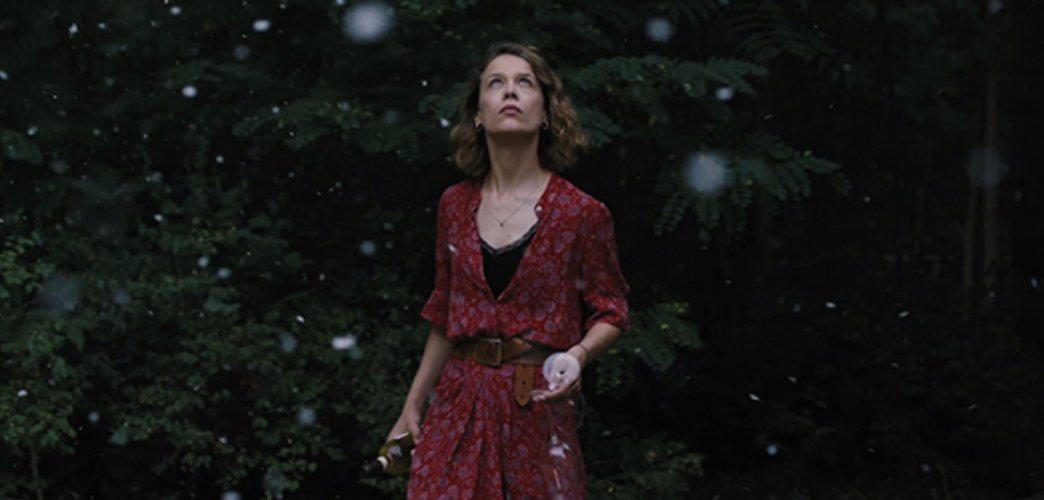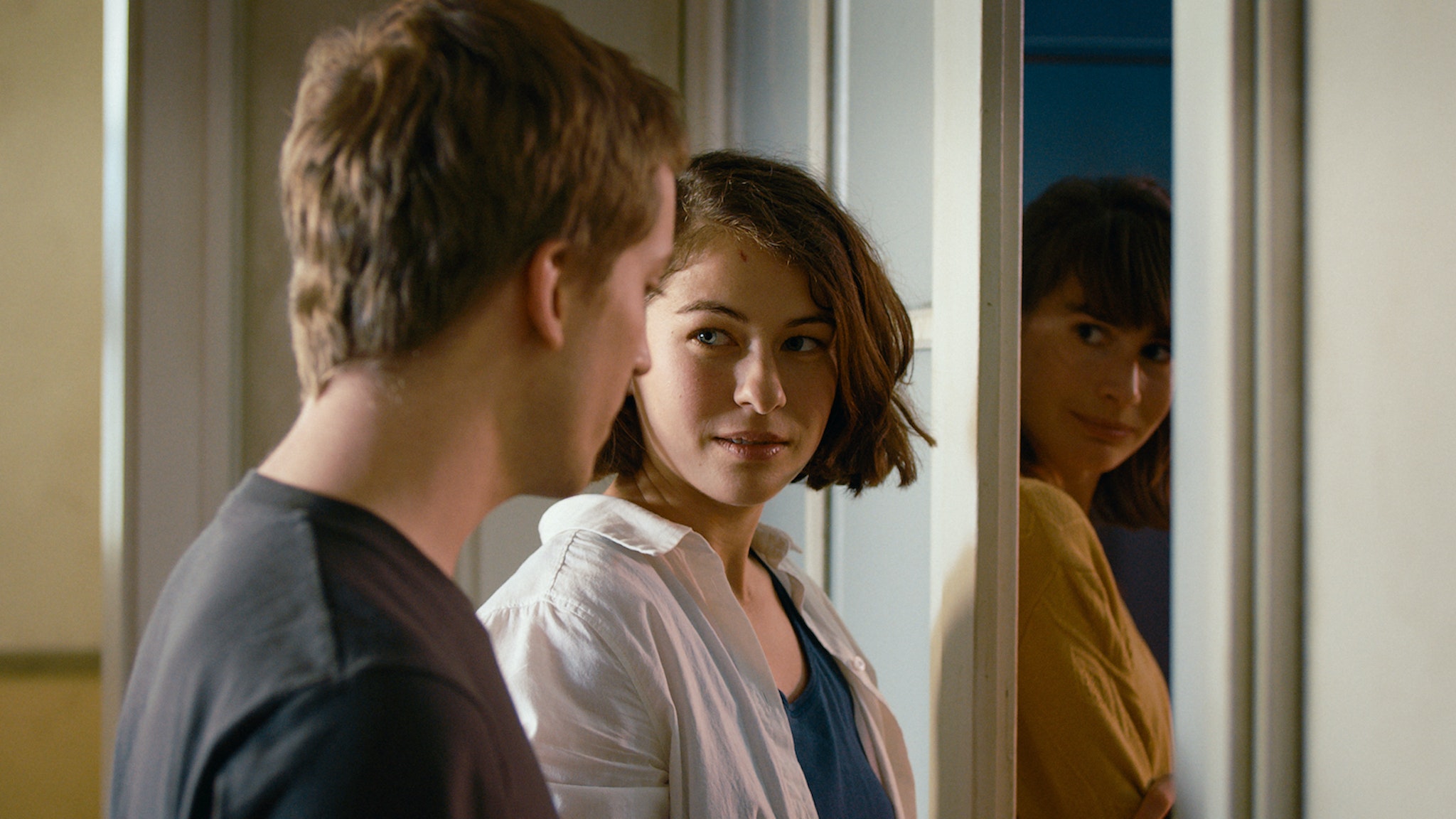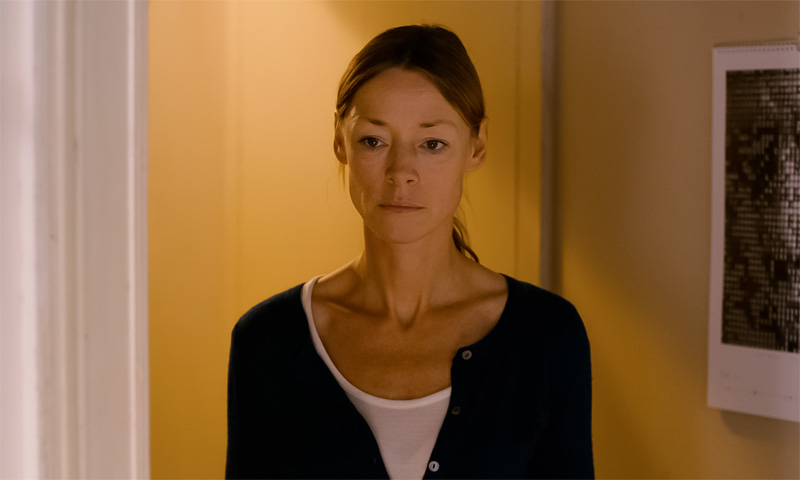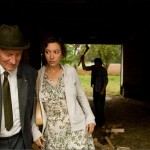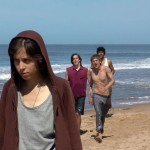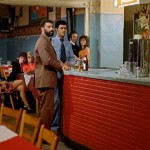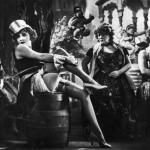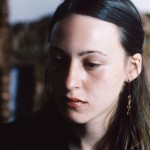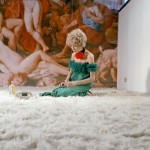This interview was originally published at Cinema Scope.
* * *
“And then sometimes I start lying.”
Christian Petzold becomes bored with his own voice during press junkets. “I want to tell new stories,” he confesses with a smile. “For example, I said in one interview that the next movie is about homosexual love or something like that. I’m not very professional sometimes.” I had asked him a straightforward, fact-checking question about whether his new film, Afire, winner of the Grand Jury Prize at the Berlinale, would be, as has been widely reported, the second film in a three- or four-film cycle loosely inspired by the elements: water, fire, earth, and sky. “Harun Farocki always said, ‘You know, nowadays, in arthouse cinema, they make movies like modern museums: just one fantastic building with no surroundings,’” he replied. “I love the film series of the ’40s and the ’50s. I love John Ford movies, with his stock company. I want to be part of a city and not to be in a lonely museum on the outskirts of town. And so I said Undine (2020) is the first movie of a trilogy. I must say, it’s a little bit of a lie.” Petzold is currently writing the script for his next film, tentatively titled Miroirs No.3, which will go into production in spring 2024. “I have no idea for the third part of this trilogy,” he claims. We’ll see.
A few weeks after Undine premiered at the 2020 Berlinale, cinemas shut down, as did Petzold’s plan to adapt Georges Simenon’s 1946 novel Dirty Snow, a pitch-black portrait of an amoral, murderous teenager in Nazi-occupied Brussels. While promoting Undine in Paris, Petzold and the film’s star, Paula Beer, both contracted COVID, and so he passed the next month in bed, rewatching Visconti and Rohmer films, reading Chekhov and Richard Ford novels, and developing theories about summer movies. “My children were 22 and 24 years old, and everything was forbidden for them. They couldn’t go out, no clubs, no cinema, no cafeterias, nothing. And I thought, ‘My God, what is happening to our summers?’” He was struck by the contrast with his own youth, in the ’70s and ’80s, when his thoughts of the future weren’t clouded by pandemics or the existential threat of climate catastrophe. Revisiting Rohmer reminded him of the French tradition of summer movies: teenagers on the beach, with no supervision and little to do. Discovering David Robert Mitchell’s The Myth of the American Sleepover (2010) and It Follows (2014) reminded him of the American tradition: a car, two half-naked girls, two boys with beer and tattoos, and a cabin in the woods. Petzold regretted that Germany had no such tradition. “And then I remembered that we had this genre before the fascists won their first election: People on Sunday (1930)by Billy Wilder, Robert Siodmak, and Edgar G. Ulmer. One day, summer, Berlin, young people, a lake, love, alcohol, dancing—it’s utopia. The world is open to you, like a summer night’s dream.”
After four weeks in bed, Petzold lost interest in making Dirty Snow, which was to be about “the end of morality for young people in the fascist regime.” Instead, he took inspiration from a teacher at the DFFB who had encouraged students to make films like Rohmer’s, films that in 30 years would show viewers “how people had kissed, betrayed, walked, and so on. I liked this theory.” The result is Afire, in which two young artists, Leon (Thomas Schubert) and Felix (Langston Uibel), retreat to Felix’s family cottage on the Balkan coast to enjoy the sea and to complete their latest projects. Leon is feeling pressure to deliver a draft of his second novel to his editor, Helmut (Matthias Brandt); Felix is searching for a breakthrough with his photography portfolio.
After Felix’s Mercedes breaks down—“Something is wrong” is the first line of the film—they arrive late in the evening to discover that the little house in the woods is already occupied by the beautiful Nadja (Beer), a seasonal worker in the local tourist town, and that a forest fire is raging 30 kilometres to the west. The next morning, Leon spots Nadja through the kitchen window, mounting a bicycle in a red summer dress and riding alone into the woods. Until then, she had been for him only a figment formed by the traces she’d left in the house: a half-eaten meal, lingerie on the floor, and the sounds of sex with lifeguard Devid (Enno Trebs) bleeding through their shared bedroom wall as he tried to sleep.
Afire is a fairy tale by way of Rohmer’s La collectionneuse (1967). For Petzold, the greatest shock of watching that film for the first time in decades was discovering that Rohmer had given agency to Haydée (Haydée Politoff), the object of desire, in ways that the men in the film were oblivious to—and that the twentysomething Petzold who first viewed it had overlooked as well. “It was like a slap in the face! I asked myself, ‘What is your perspective of the world? Of women? What kind of male subject are you?’” Leon, then, is by Petzold’s own admission some version of himself at that age: insecure, pretentious, condescending, an observer of the world rather than a participant in it. And Nadja, like Haydée, is also more than she at first appears.
Cinema Scope: Near the end of the film, as the fire is approaching, Leon confesses his love for Nadja, and then the plot turns in unexpected directions. The final act is open to interpretation, but I imagine you probably have a very particular understanding of what happens. Is it important to you that the audience interprets the end correctly?
Christian Petzold: No, it could be different. After the premiere, my children had a different understanding of the end. For my son, it was as if the movie had put things together again. The world could go on. We have a future.
I read an interview with a Brazilian football player who for his whole life wanted to win the World Cup. And he said later that when they won, it was a moment of presence without any reflection. But then he heard his name over the loudspeaker, and in that moment, it was past, it was gone. This is fantastic! For me, this happens in movies sometimes. Movies are always in the present. Even in a historical film like Barry Lyndon (1975), you see an image of the past, but it’s still now. It’s always now. But the voiceover in Barry Lyndon is somehow very far away.
For me, this happens in this moment when Leon says to Nadja, “I have loved you from the start.” Idiot. For the first time he wants to open himself up in this moment, but everything’s closed. The police are coming. Death is coming. He can write a novel, but in the same moment when he can write a novel, he’s losing his love, he’s losing his desire.
Scope: How we interpret the shape of the film affects how we interpret Leon. The snippet we hear from his draft novel, Club Sandwich, is laughably bad. But is Leon a bad writer? How did you conceive of him as an artist?
Petzold: I wrote two or three pages of Club Sandwich. It’s very hard to write a bad novel! But I wrote it in about one hour, these three pages. And I was a little bit proud of it. I thought, “It’s not so bad.” Then, during rehearsals, the actors, especially Paula and Thomas, said to me, “This is a really bad novel, it’s so embarrassing.” And I started to say, “No, no, it’s not so bad.” I was a little bit angry about that—the criticism. And then they asked, “What’s the title of your second movie?” The actors in this film are all very intelligent; I love working with intelligent actors. Like detectives, they understood that in this artist, Leon, there’s a big part of my own biography. I said, “The title of my second movie is Cuba Libre (1996).” Cuba Libre. It’s a drink. And they say, “Club Sandwich? Cuba Libre? It’s similar. You can order them both in your hotel for lunch.” I started laughing.
When I made Cuba Libre, I was playing a director. I’d had success with the first movie, so the second movie, I knew, was very important. I wanted to say to the world what a great auteur I was, what a great cineaste. We shot on 35mm. There were quotations from Edgar Ulmer’s Detour (1945). We used many of Jean-Pierre Melville’s locations on the northern coast of France and Belgium. After five or six days of shooting, my wife—she was not yet my wife then—said to me, “What is happening to you? You are playing a director. I don’t believe you.” I was totally depressed. In two nights, I changed the perspective of the script. I put away the beautiful girl in the story and made a portrait of the male subjects, and this rescued the movie.
I told this story to the actors, and I think they needed to know that Afire is partly about being a male-subject artist in this world, and that I’d had this experience myself 25 years ago.
Scope: To make sure I understand your earlier point, at the exact moment Leon chooses to stop being a pretender and enter the world, the world closes itself off to him. Is this ironic?
Petzold: No, not ironic. I think it’s punishment. Perhaps it’s self-punishment, given what I’ve told you about Cuba Libre. He’s open to her in this moment, but it’s too late. How can he expect a kiss or tenderness from her now? At the beach, he had a chance and missed it. The punishment is delivered by the structure of the movie—by the Sakamoto Ryuichi cue, by the arrival of the police. I’m bored with police cars in films, but I like the image of Leon standing there with no glass, no window between him and Nadja, and behind them there is the world, and the police are coming. They arrive to punish him for his moral failings—for his bad summer and his bad friendship and his bad behaviour. Once he’s been punished, he can write.
Scope: My sense of Leon is that when he’s at his worst—insulting and patronizing Devid and Nadja, for example—he’s overcompensating out of an insecurity that has more to do with class than talent.
Petzold: I’m glad you asked this. It was very important that we have two friends from different social classes. There’s no dialogue about this in the movie, but you can feel it—that Felix is paying at the supermarket, that he’s the owner of the house, that he has no fear about the car breaking down because his mother will just buy him another one. In German private schools for the upper class, 25% of students are on scholarship, and for this 25% it’s a very hard life, surrounded by rich kids. They don’t wear the same clothes, they don’t go on holidays with their parents. This is important for me, but it’s not in the dialogue—it’s in the bodies, in the behaviour. Leon is from the working class, and he’s jealous. His self-confidence is weak. He hides behind a hard mask to survive.
Scope: There’s another interesting class issue in the film. Afire is set on the Baltic Sea, in what was East Germany. At one point Felix makes a condescending comment about Devid’s name. For non-German viewers like me, is this just the standard snobbishness city people often feel about the provinces, or does it reflect a historical/cultural divide between the West and East?
Petzold: It’s a West-East divide. In the former German Democratic Republic there are small cities with names like Boston and Philadelphia, and people who live there have names like Mike and David. It’s a long history, going back to the 18th century, when people there wanted to start new lives in the US. Frederick, the King of Prussia, said, “No, stay here, we need you to build up agriculture, to feed our nation.” And he gave them money and farmland, and they formed villages named Philadelphia and Boston because that was their desire.
Two hundred years later, the people of the GDR couldn’t leave because they were behind a wall. But they wanted to reach the US, to drive an American dream car, to see California and the Pacific. They had American music and American literature and American cinema, so they gave their kids names like Mike and David. But they had to spell them so that they sounded American, so David became Devid.
My parents are refugees from the GDR, but I was born in the West. When I shoot at the Baltic Sea, for example, or shoot in the east part of Germany, when I shoot in places my parents dreamed of before they escaped, I respect this. I respect the dreams of my parents.
Scope: Most of your films have a romantic couple at the centre, so I find it interesting when you expand the cast—for example, the dozen or more speaking parts in Transit (2018). In Afire, your main cast is four men and one woman, and there’s a kind of fluid desire passing between all of them, which seems new for your work. I’m curious to hear how you approach constructing that flow of desire, formally. Is it just a matter of cutting on an eyeline match from one fascinating face to another?
Petzold: The couples in my movies are always one woman, one man, so the shot/counter-shot strategy works, but I was a little bit bored of this, I must say.
Most German actors come from the stage, because theatre is so important in Germany. Our theatres are the best in the world, with fantastic actors for the stage. We have fewer good actors for movies, because cinema is not as important for our social and cultural life. For me, shot/counter-shot is so important in cinema because you are in the space and in the tension between two people. When actors are on stage, you’re never between them—you work instead with speech and choreography, but the audience will never be inside. Most actors don’t understand this when they are in front of a camera: they speak and act for an audience, like they’re on stage.
I talked about this with my actors. Most of them are not from acting schools. We had rehearsals three months before shooting, and we went to the locations before they became crowded with the production crew. They are still innocent, these places, they have their own dignity. So, for example, there was a table in front of the house, and I said to the actors, “I think we can use this space when the characters are talking, or when Nadja reads the poem.” And then I sat 100 metres away and watched the actors walk around. They looked at the house and trees, they sat down at the table. And who sits where is very important. Paula sits on the edge, the other guy sits there. They find their position in space, and they find their position in the group. I like this so much. It’s like when an abstract painter stops and says, “This is right.” By finding their positions, they also find out something about their characters—not by psychology, but by choreography. I watched a documentary three or four weeks ago about Visconti’s rehearsals, and they were exactly the same. You have to wait.
I remember this time as my happiest time of making movies, these three days in the forest near the sea.
Scope: Did you design the house? The windows play an important role in several scenes.
Petzold: Leon is not part of the world. His working place is like a stage. He’s always looking at the world through windows, through doorways. He hears the world behind walls. So, yes, we built the house, with many windows, allowing access to many perspectives. I told the actors, “We have built this house so that everybody can look at each other.” They can’t hide. And they loved it. They each found the room they wanted and the bed they wanted to sleep in. We built up the kitchen, so that when you’re in there you can look outside and inside. And when you’re looking outside, you are on a higher position, like Napoleon, like from a hill. This gave the actors opportunities during rehearsals to find connections to each other and to establish positions of power or weakness.
Scope: Your earlier interviews give me a sense that your collaboration with Harun Farocki revolved around food and smoking and long conversations about cinema and economics and human nature. Has your writing process become more solitary since Farocki died? I’m sure he can’t be replaced, but have you found other people to engage in those types of conversations?
Petzold: His grave is not far away from here. Remember in Young Mr. Lincoln (1939), the scene where Henry Ford is at the grave of Ann Routledge and asks her advice? It’s a little bit like this when I’m writing and I go to his grave. We have a conversation. I want to remember the ideas that were very important for us. For example, we believe that in a film each location should be used twice, and the different atmosphere of the two scenes is the story. In Antonioni’s L’avventura (1960), a young woman has vanished but first we see her in a village. Then, three months later, when they are looking for this girl, they come back to the same place. Antonioni positions the same extras on the staircases, and in the cars, and you remember this place as a place. But something has changed. And this difference is important. This is something I always have to remember when I’m writing—that places like the beach, the table, the forest, we are there twice, but something has changed. Dialogue is not necessary; it’s something the audience can feel.
Now I’m solitary, but in another way. Now, I’m talking to Paula Beer. I’ve become friends with more actors, and I can talk with them about scripts. There is no vanity. It’s very interesting, because I must say Harun and I, we are male subjects and we are cineastes. We are architects— you can live in a good script like in a good house. But I need someone else, too, who can tell me more about the people who live in this house. There was a woman who was very important for me, the casting agent Simone Bär, who died six weeks ago from breast cancer. With her, it was like I had bought a house and could ask her, “Where are the bedrooms? And where can the kids play?” She brought a warm energy to this structure.
Scope: I’m sorry to hear about Simone Bär. Did she help cast Thomas Schubert?
Petzold: Yes. I saw Thomas in Dominik Graf’s Police Call 110 (Bis Mitternacht, 2021). He’s a killer, and he is fantastic. Then, Matthias Brandt made a Netflix series (King of Stonks, 2022) with him. Simone said to me, “The actor who plays Leon, please don’t cast someone handsome, because the audience will hate him.” The audience must identify with Leon, and when he’s too handsome, he’s not part of you.
Thomas is a really fantastic actor. He sees the world. He’s interested in the world, and he’s interesting to the other actors. Simone told me, “He’s looking into the eyes of others.” And so many actors never do this—they just look to themselves. But he’s always changing. It’s another kind of dialogue.
Scope: I’m a few years younger than you, but I think we’re the same generation of cinephile. When I was young, I could only see a handful of Hitchcock films on TV. So as a teenager, I would check out Hitchcock/Truffaut from the library and read those conversations, stare at the black-and-white still images, and imagine the films. In hindsight, I think that experience made me an auteurist critic. How was your understanding of cinema and the job of a director shaped before you moved to Berlin?
Petzold: Totally similar to your biography. I grew up in a small town without cinema, so the library was my cinema, and it opened everything. I read the same book, Hitchcock/Truffaut, an ugly book in Germany, with terrible black-and-white pictures inside. But I think you always need someone who opens your eyes and your mind. You have to be a pupil.
I remember at this age sitting on a bench in a park, and the boyfriend of a friend of mine was sitting beside me. We were smoking cigarettes, and I was talking about two records I had bought—by Dire Straits and Phil Collins, I remember! And he said, “This is shit. Total shit. You can visit me tomorrow and I’ll give you a lesson.” So I went to his place and we listened to the Residents and Devo and all of the bands on Rough Trade and so on. He explained everything for me, and I must say I learned to hear from him like I learned to see from Hitchcock/Truffaut.
Then, when I was 18, there were film clubs in Wuppertal and Dusseldorf and Cologne, and there were teachers who would introduce the movies. I saw all of Hitchcock’s movies when I was 18. I saw all of Howard Hawks’ movies when I was 19. You have to learn to see. At first I wanted to write about cinema, but then I changed to the other side. I was 26 or 27 when I became a student at the DFFB in Berlin. At the time they didn’t want young people—they wanted people who’d already experienced l’education sentimentale! I remember Jean-Luc Godard said, “I have to be 30 to make my first movie.”
Scope: It was interesting to watch Afire and Angela Schanelec’s Music on back-to-back mornings in Berlin. Both are great films, and both are very pleasurable viewing experiences, but the pleasures are very different. Her montage is becoming increasingly elliptical, associative, private; yours is classical and efficient. At this point in your life, how do you think about the pleasures of spectatorship?
Petzold: In 1991, 1992, Angela and I were in the same seminars. We saw and talked about the same movies. It was a fantastic time to learn to see at the editing table in front of movies like To Live and Die in L.A. (1985). Every day there was a new movie on the editing table, with fantastic professors like Harun Farocki and Hartmut Bitomsky who opened our minds. I think there are correspondences between Angela’s movies and mine. I love to see Angela’s movies. I’m always totally impressed by them. They are so clear.
For me, the other model was Dominik Graf. You can always find fantastic American or French directors, you can see all these fantastic movies by David Lynch and Tarantino. But when you are a student, you need someone who’s nearby, who you can touch, who you can talk to. Dominik Graf’s movies in the ’90s were like islands of rescue. I like that he tries to find the balance between the market and art.
I think avant-garde style is important when it is integrated into bigger productions, like Salvador Dalí in Hitchcock’s Spellbound (1945), or the traces of Meshes of the Afternoon (1943) in David Lynch movies. You need it. This ocean is for all of us, and we each have to find our way. I needed to find a way like Dominik Graf’s, where you please the audience and are also an auteur. This is something I learned from him. Angela and I, we have left our seminar and we are on the same ocean.
Scope: Afire seems a good example of what you’ve just described. Is it a stretch to compare its style to Vincente Minnelli or Douglas Sirk, or even John Ford, where reality is interrupted by flashes of expressionism? I’m thinking of Leon’s vision of Devid walking naked into the woods, or that image of ash dropping from the sky.
Petzold: Minnelli’s Some Came Running (1958) was the first movie I watched with the actors in rehearsals. I first saw it at the DFFB with Frieda Grafe; it was one of her favourites. At the end, after the death of Shirley MacLaine, and when Dean Martin puts his hat away, I could see through her big glasses that she was crying—when she had seen this movie 200 times in her life. She felt ashamed that she was crying, so when the lights came on, she said, “This copy is shit! This is not Technicolor! The reds are destroyed!” It’s one of my favourite movies.
For me, it was very important to discuss this movie with the actors, and not only because Frank Sinatra is a writer in the film. It has something to do with this—that you are inside of a dream. This is why we decided to shoot day for night, as in American studio films. The movie is inspired also by Shakespeare’s A Midsummer Night’s Dream, and there’s something in the idea that behind the next door there’s a park, there’s a house in the woods, there is a night, and it’s dream work. I often discussed with Harun that in 1895 the Lumières invented the cinema, and in 1895 Sigmund Freud invented dream work. It’s a correlation.
It’s an opera, Some Came Running, and it’s also total reality. I always start crying when Sinatra is reading his novel to Shirley MacLaine and she says, “It’s great.” And he asks, “What’s so great about it? Why do you say it’s great?” And she says, “It’s great because it’s from you.” I always start crying at this moment. This is one of the best love scenes I’ve ever seen in my life.
